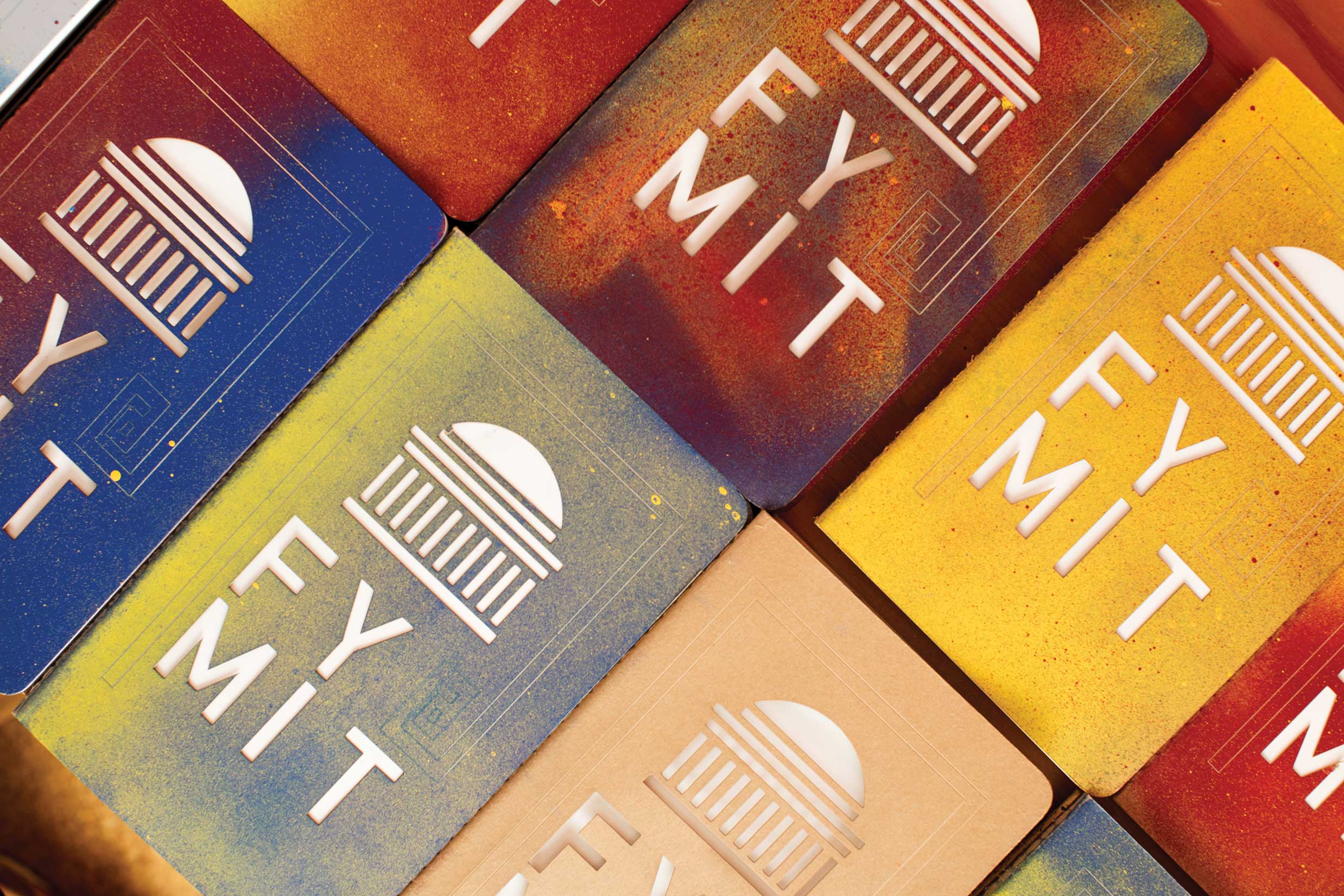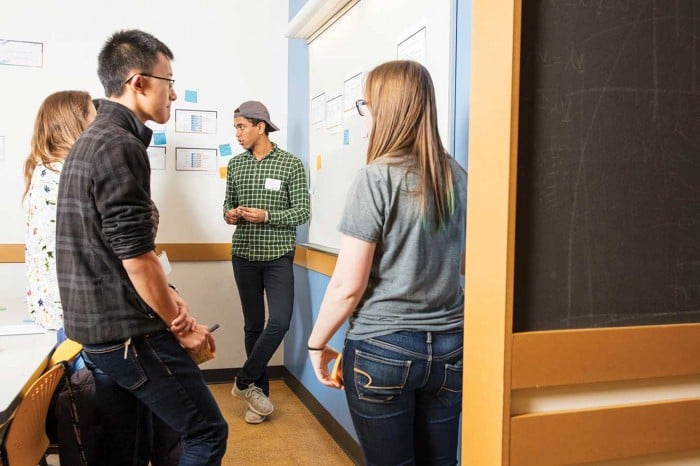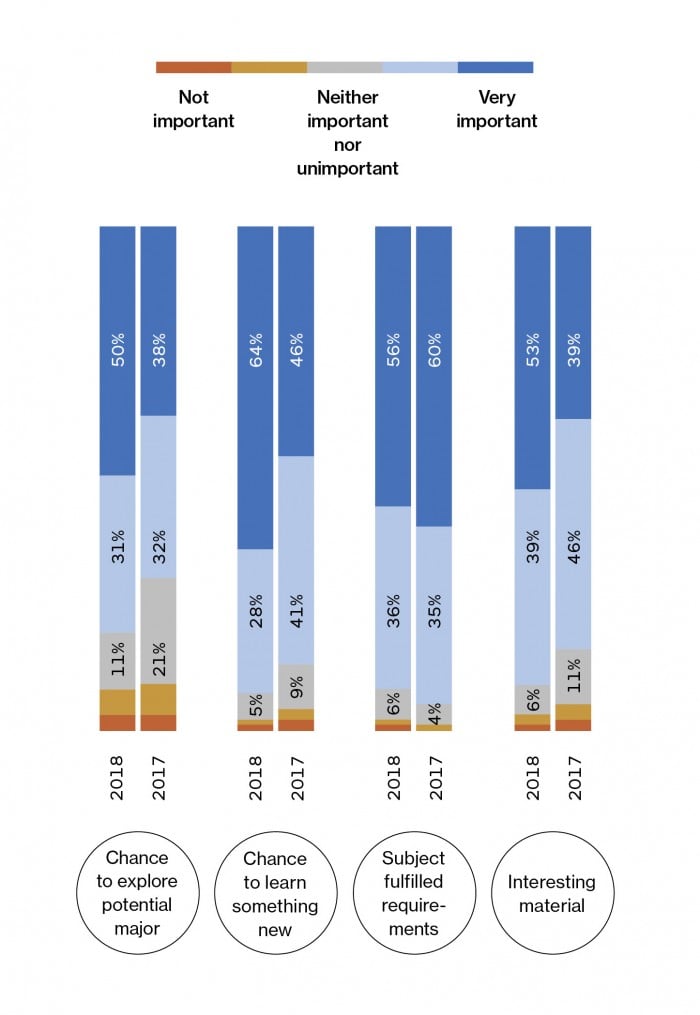The first-year experiments

On a September Sunday night, Katherine Huang hunkered down in an empty Building 5 classroom to tackle her reading from 11.401, a graduate-level course in urban planning, and write her choose-your-own-adventure story for CMS.618, a comparative media studies course geared toward juniors and seniors. But tucked into her new beige tote bag, Huang—a member of the Class of 2023—also had p-sets from her first-year biology and mechanics classes. This may seem like an unusual schedule for an MIT student’s first semester. But MIT first-years—and the Institute itself—are experimenting.
Traditionally, MIT students take (or test out of) a full year of calculus and physics and a semester each of biology and chemistry. Most of these General Institute Requirements (GIRs) were established in 1964, with biology added in 1990. Failing grades are not recorded the first year; the first semester is graded pass/no record, with no grades at all. The GIRs are known to be rigorous, and incoming students who have no idea how they’ll fare at MIT often feel pressure to pack them into the first year—preferably the first semester—to take advantage of that leniency.
While the curriculum provides a solid STEM grounding, it can leave first-year students, especially those who do not test out of GIRs, feeling trapped. Students are expected to declare a major in the spring of their first year, but 30% of first-years surveyed in early spring 2018 did not feel ready to do that, while 26% of sophomores, juniors, and seniors felt that they lacked the flexibility to change course. These results are starkly mirrored in the biannual senior survey. Asked whether they’d do anything differently if they could start over, about 400 seniors responded in 2018—and “about 20% mentioned that they would consider different majors,” says Vice Chancellor Ian Waitz.
Anywhere else, the problem would be addressed by a faculty committee. At MIT, it became the topic of a systems and design class—spun out of the office of the vice chancellor, taught by faculty from all five schools, and culminating in final presentations to faculty and administration. Bruce Cameron, SM ’07, PhD ’11, one of the lead instructors, says the challenge was perfect for the design process: “You need a substantial team, and you need input from a lot of people in the process—and that’s true when you’re designing a jet engine, and that’s true when you’re designing a chip, and that’s also true in the context of the MIT freshman year.”
Offered in spring 2018 and as a “fun-sized” IAP course in 2019, Designing the First Year at MIT (DFY@MIT) involved more than 100 students, faculty, and staff (and hundreds more community members, including alumni, through stakeholder interviews and research), amounting to more than 700 person-hours a week. Compared with a faculty committee, says Waitz, the class created “a different capacity for engagement, communication, and even rigorous analysis.”
Erick Friis ’18, MEng ’19, now a software engineer, took the class to learn more about product and education design. His group developed MIT Explorer, an Amazon-like platform to help students choose courses and activities; it was meant to eventually incorporate student reviews. The concept was to let students weigh potential choices and accurately gauge time commitments. (The framework of the site, he says, is an open-source shopping website.) After the course ended, a working prototype informed the new MIT Engage website for student activities. Another team’s ideas for redesigning and relocating the extracurricular activities fair known as the Activities Midway to decrease crowding and student stress were implemented in fall 2018. Other student ideas, many of which twined through multiple final presentations, required more major academic overhaul.
Enter the first set of experiments, known as Phase 1: as of fall 2018, when the Class of 2022 entered, students are allowed to delay up to three GIR subjects with pass/no record grading beyond the first semester to make space for exploration in the first year. Kate Weishaar ’18, now the project coordinator of the FYE program, was one of the students who proposed the change. The increased flexibility, she says, “came up time and time again” in conversations and research: “If you look back through old faculty newsletters or reports, the idea of P/NR GIRs keeps popping up.” It was also attractive to students. In a 2018 survey on majors, 77% of the class of 2021, retroactively declared the control group, indicated that it would have helped them choose a major.
Phase 1 had profound and immediate effects on course selection. First-semester enrollment in the GIRs fell by 17%, with most of the decrease concentrated in the life sciences—a 21% decrease in chemistry and a 63% decrease in biology. Meanwhile, first-semester non-GIR enrollment increased: 67% in the sciences, 114% in business, and 47% in engineering. First-year enrollment in 6.042, Mathematics for Computer Science, rose to 116, from 15 the previous fall. 6.009 (Fundamentals of Programming), 14.01 (Principles of Microeconomics), and 9.01 (Introduction to Neuroscience) also saw massive increases in first-year fall enrollment—444%, 213%, and 1,300%, respectively. All told, first-years enrolled in 38 more unique classes than their counterparts the previous year, most of them recommended exploratory classes.
First-semester participation in the Undergraduate Research Opportunity Program (UROP) nearly doubled, from 11% of first-year students in 2017 to 19% in 2018. The proportion of students participating in UROP by the end of the first year increased only from 61% to 64%, but the increased participation is continuing into the sophomore year: 41% of sophomores applied to participate in UROP as of October 31, compared with 34% last year.
Faculty are increasingly excited about first-year students working in their labs, say UROP senior program coordinators Melissa Martin-Greene and Sara Nelson. Both the UROP office and individual departments have increased first-year programming—including a civil and environmental engineering mini-UROP and introductory research courses in chemistry, management, and molecular biology (the latter two added just last year).
This fall, Phase 2 of the experiment got under way with several additional modifications to the first-year experience. Early sophomore standing (ESS), previously accessible only with incoming credits, was eliminated, and its perks were extended to all students. Now all first-years can get pre-major departmental advising and take up to 60 units’ worth of classes in the spring (up from 57). Phase 2 first-years also get a separate nine units for discovery in the fall and another nine in the spring, which they can use for first-year advising seminars, UROPs, or new first-year discovery classes.
Discovery classes have low workloads (only 1 to 3 units each, compared with the 9 to 12 of a typical class) and incoming students can now choose from more than 20 such classes, including Climate Change, Explorations in Management, and The Future: Global Challenges and Questions. Some discovery classes, like The Sum of All Courses, aim to introduce students to faculty, majors, and MIT lore; others, like Careers in Medicine, focus on personalized career planning. Exploring Globalization through Chinese Food, taught by Emma Teng, a professor of Asian civilizations, includes immigrant-made documentary films, a Chinatown field trip, and a lesson from visiting scholars on how to make dumplings (350 dumplings, to be precise).
Economics professor Ben Olken, who created a discovery course called Economics and Society’s Toughest Problems, says such classes are a welcome complement to the “foundations-up perspective” of introductory courses, allowing students to preview big-picture questions they’ll see in junior or senior year. In some cases, non-academic departments are offering credit-bearing classes, like Transforming Good Intentions into Good Outcomes, taught by Sarah Bouchard and Alison Hynd of the PKG Public Service Center.
“Discovery classes in particular are something that came out of the Designing the First-Year Experience class,” says Weishaar. Independently proposed by four student groups in DFY@MIT, they were ranked in an IAP survey of Phase 1 first-years as the change most likely to improve major selection—above delayed major declaration, full-workload exploratory courses, or increased interaction with faculty (a close second).
This fall, 425 first-year students (38%) enrolled in discovery classes; 88 took more than one. First-semester students took 332 unique courses, while GIR enrollment was comparable to that in Phase 1: 41% of first-year students took three or more GIRs, compared with 44% last fall and 77% in 2017. The average first-year student took just 2.3 GIRs this fall.
In an orientation-week survey of Phase 1 students, first-year course selection was guided less by requirements and more by interest in exploring a major, interest in the material, and interest in learning something new (see chart on opposite page).
Surveyed again during IAP, Phase 1 students felt about as prepared to choose a major as the class before them—but were more open to changing their path, more interested in exploring new majors, and less stressed about choosing one.

Katherine Huang says taking upper- and graduate-level courses her first semester is helping her choose between two majors. Especially helpful, she says, are interactions with graduate students and hands-on projects with connections to the world beyond MIT.
Last year, Kylie Hansen ’22 used the added flexibility of Phase 1 to take Introduction to Astronomy (8.282) in the spring, leading to a UROP last summer. As a sophomore, she is continuing her research and took 12.410, Observational Techniques of Optical Astronomy, for which 8.282 is a prerequisite. The ability to delay the biology GIR, she says, “was the great stepping--stone to where I am now.”

Some faculty are concerned that delaying GIRs, especially in the life sciences, locks students out of classes and majors later on. “If you put off GIRs to your last semester,” says biology professor Hazel Sive, “you may well have fooled yourself that you’re not interested in a particular subject, and in fact you found it fascinating.” (The number of students declaring life sciences majors has not decreased, but biological engineering professor Linda Griffith says that may be thanks to increased recruitment efforts.) Conversely, departments not represented by the GIRs welcome the change. Economics professor Josh Angrist, who was inspired to pursue economics by a first-semester class at Oberlin, laments that his econometrics class is usually full of juniors and seniors. “They might have liked to major in economics,” he says, “but it’s too late.”
Yet Anne McCants, director of Concourse (a first-year learning community that offers small classes in the math and science GIRs and the humanities), thinks it’s okay if students don’t figure out their ultimate path by the end of the first year—or even by graduation. Now an economic historian, McCants discovered her passion for history only after earning a degree in economics. (Like her, 75% of MIT alums leave their major field within five years.) “I don’t see people changing their mind as a sign that an education has been a failure,” says McCants. “You got an education. You figured something out along the way.”
The most important results of the experiments are yet to come, as students declare majors and discover and develop their passions at MIT and beyond. In the meantime, the Institute is pursuing a broader trend toward more flexible, customizable education, including the cross-departmental, project-based New Engineering Education Transformation (NEET) program and new interdisciplinary majors such as Humanities and Engineering (Course 21E), Computation and Cognition (Course 6-9), and Computer Science, Economics, and Data Science (Course 6-14).
“If the first year can be transformed,” says architecture professor John Fernandez, director of the Environmental Solutions Initiative, “there’s a sense that other parts of MIT are fair play for improvement and creative ideas.” In addition to teaching the discovery class on the future, Fernandez is integrating environmental topics into GIR p-sets. Meanwhile, an advising program that supplements the faculty advisor with an advisor specializing in the first year is being piloted, as are project-based assessment and climate science modules in the GIRs in the Experimental Study Group (MIT’s original first-year learning community, which marks 50 years of experiments in education this year). And in Concourse classes, students are relieved of a week’s worth of homework so they can attend on- and off-campus events. (In the fall, they used the time to attend physics colloquia, political rallies, lectures on ethics, economics, and media, and both pop and classical concerts.) The DFY@MIT class, says Waitz, “got everyone at MIT thinking about not so much if we should change but how.”
The point of the experimenting, he says, is not to find a “right” answer, but to keep catalyzing change. Will there be a Phase 3? “We’re certainly going to push for continued experimentation,” says Weishaar. The ultimate goal, she says, is a first-year experience with “less stress, more inspiration, and a better sense of who you are and where you’re going in life.”
Keep Reading
Most Popular
Large language models can do jaw-dropping things. But nobody knows exactly why.
And that's a problem. Figuring it out is one of the biggest scientific puzzles of our time and a crucial step towards controlling more powerful future models.
How scientists traced a mysterious covid case back to six toilets
When wastewater surveillance turns into a hunt for a single infected individual, the ethics get tricky.
The problem with plug-in hybrids? Their drivers.
Plug-in hybrids are often sold as a transition to EVs, but new data from Europe shows we’re still underestimating the emissions they produce.
Google DeepMind’s new generative model makes Super Mario–like games from scratch
Genie learns how to control games by watching hours and hours of video. It could help train next-gen robots too.
Stay connected
Get the latest updates from
MIT Technology Review
Discover special offers, top stories, upcoming events, and more.